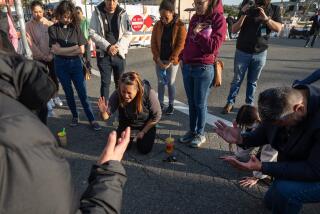Booklet Explains U.S. Schools (Field Trip? Pep Rally?) to Asian Parents
Hoping to remove some of the mystique of the American educational system, a San Gabriel Valley Asian group has published a guide for newly arrived Chinese parents bewildered by such peculiar institutions as the Friday night pep rally and the PTA.
The eight-page booklet, available in English and Chinese, covers the philosophy behind American public schools, the importance of outside activities such as field trips, school dances and sports and the need for a partnership between parents and teachers.
“We found that Asian parents are confused about what their children are doing in schools,” said Barbara Lee, a licensed clinical social worker and a member of the San Gabriel Valley Asian Task Force, which published the booklet.
“There was confusion over ‘why my son needed to take that field trip’ or ‘why my son had only two homework assignments this week.’ ”
“With the booklet, we’re hoping that parents find out that ‘Hey, this system isn’t wrong. It just works differently. This is just a different point of view,’ ” Lee said.
Schools officials, confronted with a growing Asian population, have struggled in recent years to involve Asian parents in their children’s education.
Parents are concerned about grades and attendance, school officials say, but many fail to see the importance of attending parent-teacher conferences, joining the PTA or volunteering for school functions.
But what appears to be parental apathy is, on closer inspection, really a basic difference rooted in culture and language, according to teachers and administrators.
In Asian culture, teachers are considered a supreme authority; questioning them or meddling in school affairs is seen as disrespectful and presumptuous. And for a newcomer parent unable to speak English, a visit to an American school can be a confusing and embarrassing experience.
But while recognizing these differences, school administrators continue to experience frustration in their attempts at reaching out to Asian parents. A few school districts have even resorted to evening tea parties with Chinese music as a way to bring out Asian parents. The results have been less than encouraging.
“Asian parents look at teachers and school personnel as the ultimate authorities,” said Stephen Lee, a computer lab teacher at San Gabriel High School, where 29% of the student body is Asian. “We are the professionals. We’re supposed to have all the answers.”
Last week and again on Monday, task force members presented the booklet--the first in a series of educational guides the group hopes to publish--to school districts and mental health agencies.
They said the emphasis on grades had discouraged Asian children from participating in after-school activities--an important ingredient in promoting racial understanding on some San Gabriel Valley campuses where Asians now account for nearly half the student body.
Members of the task force--a volunteer group with representatives from 40 educational, social and mental health agencies--underscored the need for more funds to translate the booklet into Vietnamese and Korean. Donations covered the cost of the Chinese booklet, $1 per copy. The group also hopes to print additional booklets helping Asian parents deal with such issues as drug and sexual abuse.
Brian Leung, co-chairman of the task force’s school committee, cautioned school administrators against distributing the booklets through students. Leung said that the booklets will be made available free to any interested school district, but that school officials should pass them out to parents only after giving public presentations.
“Parents need to be in groups, and the ideas in the booklet need to be presented orally by the schools,” said Leung. “We don’t want the booklet to just end up on someone’s shelf.”
Gay Wong, an Alhambra School District bilingual specialist who attended the Monday presentation, said the booklet was a necessary first step to involve Asian parents in the educational experience.
But Wong said she would not distribute the booklet in her district unless the task force gave her approval to change illustrations that used slanted lines to depict the eyes of Chinese parents and students.
“We’re trying to get away from the stereotypical depictions,” Wong said. “It’s an awareness that needs to be pursued. I’d like permission to change it.”
Leung encouraged Wong to alter the illustrations. He said the group was still feeling its way and had made other mistakes, such as giving school districts only 10 days’ notice to attend the presentation.
More to Read
Sign up for Essential California
The most important California stories and recommendations in your inbox every morning.
You may occasionally receive promotional content from the Los Angeles Times.










